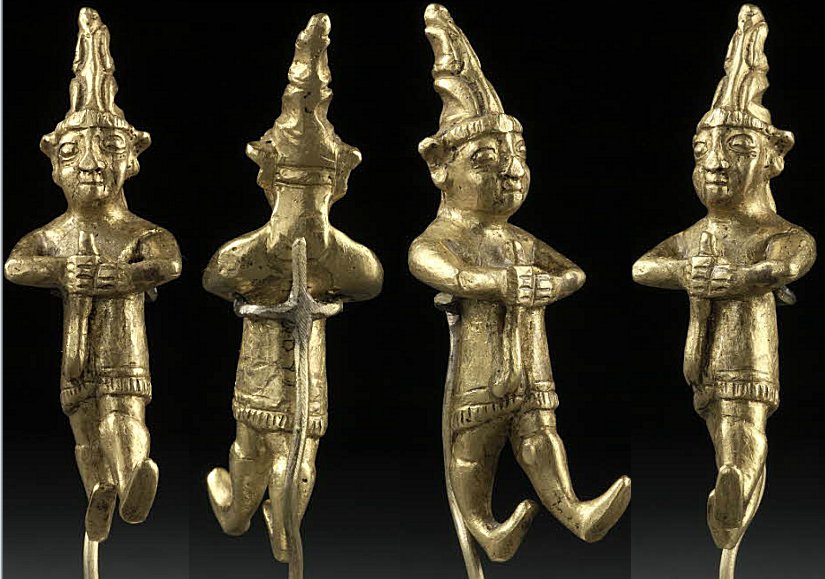Golden Figurine From Yozgat Depicts Unknown Hittite God
A. Sutherland - AncientPages.com - Hittites were one of the most important ancient civilizations of Asia Minor. They ruled the central Anatolian kingdom of Hatti from c. 1900 – 800 BC., and worshiped a number of gods and goddesses; they were described as the “civilization of 1,000 gods”.
As the conquerors of many lands, the Hittites found it useful to adopt the gods of other cultures into their own religious pantheon. Thus, the Hittite religion came to include gods worshiped by the Babylonians, Assyrians, Hurrians, and others, as well as the gods of the indigenous Hattian people of Anatolia.
The second reason for this massive number of gods is that most cities and towns in the Hittite empire had their own versions of similar deities. Thus, a single god could end up being turned into several different local deities with little difference between them other than the name.
Like many other ancient civilizations, the Hittites worshipped weather gods and the God of Storm. The preserved Hittite art consists primarily of reliefs, often architectural. There is also art in the smaller format, which developed during the Hittites' the Middle Kingdom that lasted from the 15th to 14th century and was a rather weak phase in the empire’s history.
During this period - largely unknown with very sparse surviving records - the art of Hittite diplomacy was developed.
This figurine from Yozgat is an example of this kind of art.
It is an amulet pendant (H. 3.80 cm; W. 1.30 cm; D. 1.30 cm), depicting the Hittite god from the time of the Hittite Empire. It was used by the ancient Hittites during the time when the Israelites were slaves in Egypt.
The figurine’s divinity is indicated by the short garment and the tall conical tiara; the sword in his hands additionally suggests that he is a warrior god, Teshub, the Hurrian god of sky and storm. Several myths about Teshub survive in Hittite versions.
Teshub is often depicted holding a triple thunderbolt and an axe (often double-headed) or mace.
In the religions of Asia Minor, the Hurrian weather god was assimilated by the Hittites to Tarhun, the central Hittite god related to the sky, weather, and thunder. According to a myth, one of Tarhun’s greatest achievements was the slaying of Illuyanka, a powerful dragon or serpent.
Written by – A. Sutherland AncientPages.com Staff Writer
Copyright © AncientPages.com All rights reserved. This material may not be published, broadcast, rewritten or redistributed in whole or part without the express written permission of AncientPages.com
Expand for referencesMore From Ancient Pages
-
 Ancient Secrets Of The Amazon Jungle – Dangerous Expeditions And Hidden Treasures – Part 1
Ancient Mysteries | Mar 1, 2019
Ancient Secrets Of The Amazon Jungle – Dangerous Expeditions And Hidden Treasures – Part 1
Ancient Mysteries | Mar 1, 2019 -
![Photo taken on Dec 20, 2015 shows hoof-shaped gold ware unearthed from the main coffin in the Haihunhou (Marquis of Haihun) cemetery, East China's Jiangxi province. [Photo/Xinhua]](https://www.ancientpages.com/wp-content/uploads/2015/12/MarquisofHaihuntomb1-307x150.jpg) Does A 2,000-Year-Old Tomb Belong To Marquis of Haihun? – Search For His Seal Continues
Archaeology | Dec 25, 2015
Does A 2,000-Year-Old Tomb Belong To Marquis of Haihun? – Search For His Seal Continues
Archaeology | Dec 25, 2015 -
 Likho (Licho): Puzzling And Persistent Demon Of Mischief In Slavic Mythology
Featured Stories | Dec 18, 2016
Likho (Licho): Puzzling And Persistent Demon Of Mischief In Slavic Mythology
Featured Stories | Dec 18, 2016 -
 Secret Ancient Knowledge Of The Toltecs Examined
Ancient Mysteries | Aug 16, 2019
Secret Ancient Knowledge Of The Toltecs Examined
Ancient Mysteries | Aug 16, 2019 -
 ‘Reforms of Shang Yang’ – Location Of Ancient Yueyang – Confirmed
Archaeology | Jan 25, 2016
‘Reforms of Shang Yang’ – Location Of Ancient Yueyang – Confirmed
Archaeology | Jan 25, 2016 -
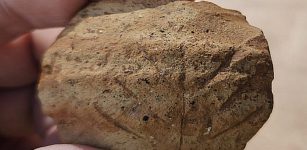 Intriguing Fragment Of A Byzantine-Era Jar Handle, Dating Back Approximately 1500 Years – Unearthed
Archaeology | Sep 5, 2023
Intriguing Fragment Of A Byzantine-Era Jar Handle, Dating Back Approximately 1500 Years – Unearthed
Archaeology | Sep 5, 2023 -
 Archaeological Evidence That Has Been Suppressed In The Name Of ‘Scientific Conformity’
Featured Stories | Sep 4, 2014
Archaeological Evidence That Has Been Suppressed In The Name Of ‘Scientific Conformity’
Featured Stories | Sep 4, 2014 -
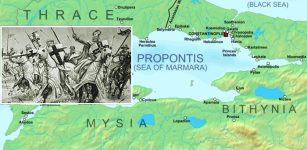 On This Day In History: Battle Of Rhyndacus – Oct 15, 1211
News | Oct 15, 2016
On This Day In History: Battle Of Rhyndacus – Oct 15, 1211
News | Oct 15, 2016 -
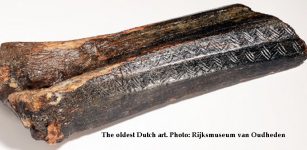 Spectacular Finds Discovered At The Bottom Of The North Sea Are 13,000-Year-Old
Ancient Technology | Feb 14, 2018
Spectacular Finds Discovered At The Bottom Of The North Sea Are 13,000-Year-Old
Ancient Technology | Feb 14, 2018 -
 Hesperides – Greek Nymphs Who Guarded Fabled Garden With Divine Apples Of Immortality
Featured Stories | Jun 4, 2020
Hesperides – Greek Nymphs Who Guarded Fabled Garden With Divine Apples Of Immortality
Featured Stories | Jun 4, 2020 -
 Cats Were Rare And Expensive During The Viking Age – Spectacular Discovery Reveals Why
Featured Stories | Jan 12, 2017
Cats Were Rare And Expensive During The Viking Age – Spectacular Discovery Reveals Why
Featured Stories | Jan 12, 2017 -
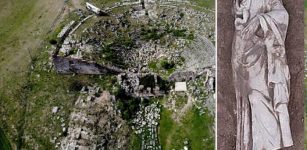 Statue Of Greek Health Goddess Hygieia – Unearthed
Archaeology | Aug 24, 2021
Statue Of Greek Health Goddess Hygieia – Unearthed
Archaeology | Aug 24, 2021 -
 Facial Reconstruction Of A 75,000-Year-Old Neanderthal Woman From Shanidar Cave
Archaeology | May 3, 2024
Facial Reconstruction Of A 75,000-Year-Old Neanderthal Woman From Shanidar Cave
Archaeology | May 3, 2024 -
 Ancient Pathogens Released From Melting Ice Could Wreak Havoc On The World – New Analysis Reveals
Featured Stories | Aug 2, 2023
Ancient Pathogens Released From Melting Ice Could Wreak Havoc On The World – New Analysis Reveals
Featured Stories | Aug 2, 2023 -
 Delphic Mysteries – Unusual Prophecy And Birth – Part 1
Ancient Mysteries | Mar 27, 2023
Delphic Mysteries – Unusual Prophecy And Birth – Part 1
Ancient Mysteries | Mar 27, 2023 -
 Bizarre And Rare Finds In Viking Houses – What Was Behind This Mysterious Practice?
Vikings | Nov 17, 2024
Bizarre And Rare Finds In Viking Houses – What Was Behind This Mysterious Practice?
Vikings | Nov 17, 2024 -
 Sweden’s Tanum And Skredsvik Petroglyphs: Thousands Of Spectacular And Intriguing Rock Art
Featured Stories | Aug 28, 2018
Sweden’s Tanum And Skredsvik Petroglyphs: Thousands Of Spectacular And Intriguing Rock Art
Featured Stories | Aug 28, 2018 -
 Why Were Ancient And Medieval People Horrified Of The Night?
Featured Stories | Nov 11, 2024
Why Were Ancient And Medieval People Horrified Of The Night?
Featured Stories | Nov 11, 2024 -
 Dracula: Cruel, Ruthless And Bloodthirsty Ruler But Not A Vampire
Featured Stories | Sep 12, 2023
Dracula: Cruel, Ruthless And Bloodthirsty Ruler But Not A Vampire
Featured Stories | Sep 12, 2023 -
 Legend Of The Blue Men Of Minch: Were They Mythological Creatures Or Real Men?
Featured Stories | May 13, 2016
Legend Of The Blue Men Of Minch: Were They Mythological Creatures Or Real Men?
Featured Stories | May 13, 2016

